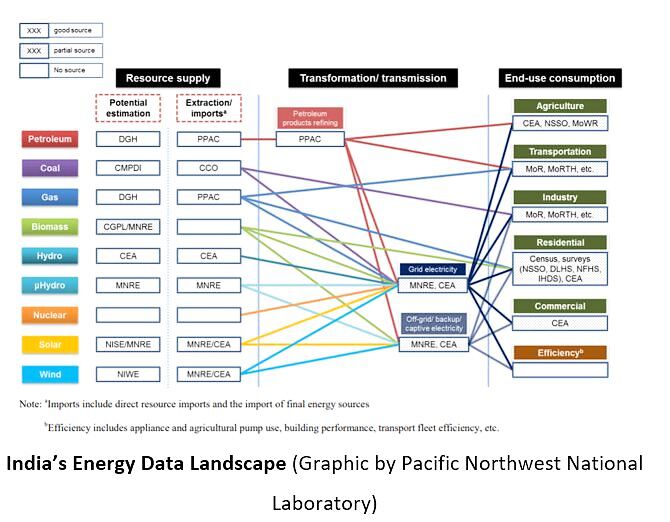
views
Before the 18th Century, oil was just another natural resource. It was widely seen and studied but scarcely used. It was not until 1859 that kerosene was discovered, and oil became a runaway success. Soon, more oil-based products were uncovered. As says history, the world was never the same again.
Today, data is extensively regarded as the new oil. In the age of analytics, data is cleaned, refined and put to use—thus becoming the backbone of the digital economy. When it comes to India’s energy sector, collecting, processing, reporting, and translating data to actionable insights is an uphill task.
A Broth with Too Many Cooks
There are persistent issues throughout the value chain of Energy Data Management (EDM): collection, compilation, and dissemination. First, there is no central agency for integrating and validating data from different sources. Apart from the five core ministries (power, coal, new and renewable energy, and petroleum and natural gas and department of atomic energy), various agencies in India maintain energy data. As a result, much of the data available is dispersed and there are significant data gaps. There are differences in the organisation of data and incompatible formats are used.
Second, there are no standardised definitions and calculation methodology of many of the key energy indicators. For instance, different calorific values for fuels such as coal and natural gas are used by different agencies in India. Different electricity consumption per capita is reported by different agencies, based on whether utilities and non-utilities are included or not. Similarly, there is a difference in the reporting of import dependency of fossil fuels because of the difference in calculation approach by various government and non-government bodies.

Third, dissemination practices vary widely due to the decentralised nature of energy data systems. There is no single space to find energy data, often shared in unfriendly data formats (e.g., scanned PDFs) and with a significant time lag. For instance, India’s Annual Energy Statistics that incorporates the overall energy balance/energy accounting is published with a one-year lag while latest electricity data is available instantly.
These practices lead to a highly unorganised space, which hampers research, delays policymaking, and weakens investments.
Developed Countries Lead in Best Practices
To no surprise, many developed countries (viz., the US, the UK, Germany, and Canada) have an efficient EDM system. Several of these EDM systems have similarities and best practices, which are easily replicable in countries like India.
Two fundamental tenets of such systems are coordination and codification. To enable coordination, EDM-efficient countries either rely on specialised agencies (e.g., Energy Information Administration – the USA) or their national statistics office (e.g., Statistics Canada) for streamlining information from multiple data sources. The need for a coordinating agency is felt even more in a country like India, where data sources are especially decentralised. As for codification, EDM-efficient countries have procedures and principles in place for data definitions and quality standards. Such standards reduce bureaucracy and lessen the need for administrative tasks such as inter-ministerial approvals.
Presence of up-to-date and validated data facilitates effective dissemination to all the relevant stakeholders, such as the policymakers, industry, international organisations, academia, media, and the public. Prompt dissemination allows for concurrent analysis and related decisions to be taken with ease. Additionally, it supports better management of national energy assets with sophisticated analytical techniques and energy modelling.
Bridging the Gap
The ambition for integrated, consistent, and reliable energy data need not be a distant one. To ensure that India leads on both the coordination and codification fronts, India needs to establish a centralised data collection and management agency. This agency would be solely responsible for collecting, validating, and disseminating all the energy data in a timely manner in India and provide a complete picture of India’s energy landscape. Such an agency can also facilitate knowledge-based policy formulation on an ongoing basis as the sector evolves rapidly. Standardised formats and reporting methodology needs to be adopted by the agency in concurrence with the respective ministries. In addition, India’s Energy Sector Handbook needs to be published that standardises the definitions, calculation and reporting methodologies for key energy indicators. The centralised data agency would be responsible for keeping the data up to date.
There has been some headway into the EDM space: many ministries have dashboards for their primary sector of engagement (e.g., National Power Portal, Online Coal Block System, and India Online Exploration Database). In June 2021, NITI Aayog launched India Energy Dashboards (Version 2), and is developing GIS map with ISRO. These are welcome steps. As the path forward, these dashboards need to be integrated with real time data and hosted on a centralised platform by the centralised data agency.
There is no doubt that strong energy data is essential for preparing and strategising for energy security of the nation. India needs to manage its energy data to better manage its energy assets. Else, the Indian energy revolution would neither be created nor be destroyed; its prospects would only bounce around from one ministry to another.
Prachi Gupta is consultant with NITI Aayog, and Aayush Gupta is Strategy Consultant with Strategy& in the Middle East. The views expressed in this article are those of the author and do not represent the stand of this publication.
Read all the Latest News, Breaking News and Assembly Elections Live Updates here.




















Comments
0 comment